

The magazine of the photo-essay

April 2018 issue


“A free, really high quality photo-essay magazine. Fabulous!”
Stephen Fry. British actor, writer and film maker
by Gary M Jones
Home to the Colosseum and the Vatican, the Trevi Fountain and the Pantheon, Rome boasts more than its fair share of
must-see historic sights. On a cobbled alleyway in one of the city’s most exclusive neighbourhoods, however, a cracked
window offers a more macabre glimpse into the Italian capital’s mysterious past.
The tiny, hole-in-the-wall workshop that is known locally as the Ospedale delle Bambole (“Hospital of the Dolls”) was
established by the Squatriti family more than six decades ago. Cracked paint peels from its window’s wooden frame, and
smashed faces and severed heads are crushed against the dusty glass.
Inside, Federico Squatriti, 52, and his 82-year-old mother Gelsomina continue the family tradition of nursing broken
antique dolls back to health. Paint-spattered and cobwebbed walls, shelves and work benches are cluttered with fractured
figurines, wounded toy soldiers and mangled puppets. Dolls’ limbs, hands and feet dangle from rusty nails, alongside
bunches of distressingly human-looking eyes.
“It has always been owned by our family, so we haven’t changed anything,” says Federico Squatriti of his grisly but
fascinating little shop of horrors, a halfway house for maimed refugees from the grimmest of fairy tales that nestles just a
casual stroll from the Gucci, Versace and Dolce & Gabbana boutiques on Rome’s chic Via dei Condotti.
“It looks like an old-fashioned shop because it is an old-fashioned shop. It’s looked the same since the beginning.”
Hailing from Naples, Federico’s grandfather Vincenzo Squatriti was an actor who performed with the respected La
Scarpetta theatre company in the 1950s. Under the stage name Enzo Petito, he later worked alongside silver-screen
legends Gina Lollobrigida and Marcello Mastroianni, and even had a small role as a gun-store owner in Sergio Leone’s
classic 1966 spaghetti western The Good, the Bad and the Ugly.
Long before that, however, in the wretched years following World War II, Vincenzo’s wife, Concetta, decided acting too
unstable a profession for her family’s future. “My grandmother urged her children to learn a craft because acting didn’t
make much money after the war,” Federico Squatriti says.
In 1953, Concetta opened Restauri Artistici Squatriti (Artistic Restorations Squatriti) in Rome with her two sons: Federico’s
father Mario and his uncle Renato. “Since then all my family has worked in here,” Federico says of his cramped workplace,
which covers perhaps 150 square feet, its air acrid with fumes of enamel paint, glue and solvents. “My grandmother, my
father, my uncle, my aunt, my cousins, my mother and myself.”
In its early years, the Squatritis’ business survived by restoring ceramic, tortoiseshell, metal, ivory and mosaic items –
mostly heirlooms belonging to Roman aristocracy that were damaged during the war. Dolls came later. While the world’s
earliest known dolls date back to the ancient civilizations of Egypt, Greece and, indeed, Rome (Roman rag dolls have been
found from about 300BC), their heyday came in the 19th century. The bodies of European dolls at that time, hidden under
fanciful costumes of lace, silk and taffeta, were often crafted from leather, rough-hewn wood or papier-mâché.
Their heads, however, were genuine works of art and increasingly made from fine porcelain. What’s more, a newfound
desire for intricate detail saw dolls starting to look creepily real, with detailed eyelashes, beauty spots, meticulously
sculpted noses, ears and lips, even wrinkles. They were no longer children’s playthings but expensive collectors’ items.
Squatriti lifts one such doll’s head from a shelf, cups it in his hand and brushes away years of dust. “It’s more than 100
years old,” he says of the antique, which bears an inscription reading 1902, adding that many items in the shop are
unclaimed former playthings of children long grown old, or now possibly dead. Some have been there for decades.
“We started to restore dolls heads because they required the same methods as porcelain, the same colours, and so on.
Maybe 40 years ago, the family started working on bodies as well.”
Today, hundreds of such period pieces are mended every year at the ospedale delle bambole, and Squatriti – like a
dedicated family doctor – feels a profound responsibility for his clients’ wellbeing. Though struggling with rising materials
costs and high rent in one of Rome’s most desirable neighbourhoods, he resists turning away new patients.
“If you want to work only seven or eight hours a day, you would need to charge more, but then fewer people could afford
to restore their dolls and antiques,” Squatriti says. Dozens of unblinking eyes appear to watch as he speaks.
“The best solution is to work well and work long enough. It’s something you do for your customers, not just for money. It’s
satisfying for me, at the end of the day, to say to myself, ‘I’ve worked for 11 hours, the result came out beautifully, and I
managed to do it for a reasonable price.’ The people are happy and I am happy. It’s all beautiful!”
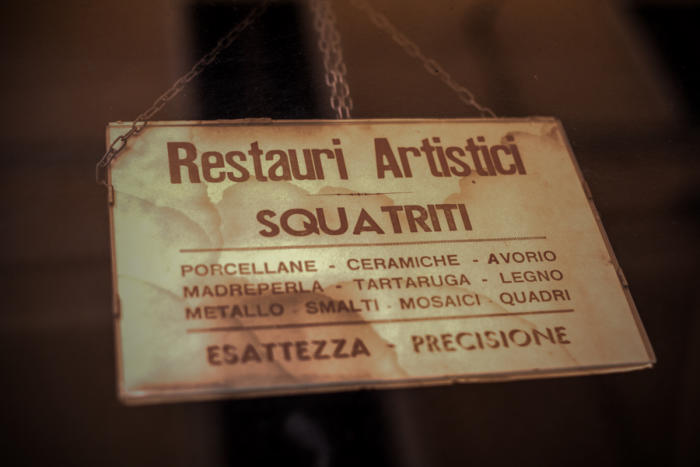
The sign in the window of Restauri Artistici Squatriti (or, “Artistic Restorations Squatriti”). The sign also reads: “Porcelain,
Ceramics, Ivory, Mother of Pearl, Tortoiseshell, Wood, Metal, Enamel, Mosaics, Paintings – Accuracy, Precision.”
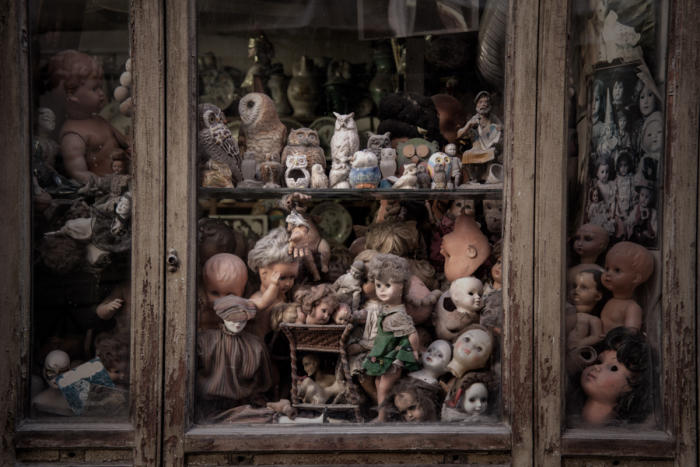
Broken dolls, ornaments, heirlooms and antiques crowd the paint-peeling window of the Restauri Artistici Squatriti, which
sits on a cobbled alleyway in one of Rome’s most exclusive neighbourhoods. The workshop is also known locally as the
Ospedale delle Bambole (“Hospital of the Dolls”).
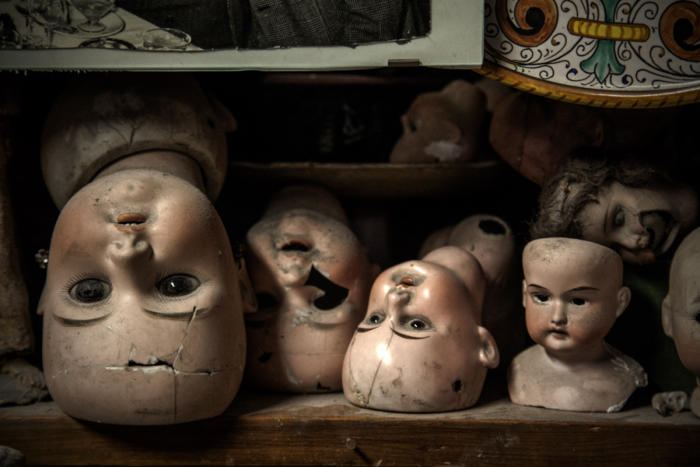
Broken heads of antique dolls line the shelves. In the 19th and early 20th centuries, the trend was increasingly for
realistic-looking dolls, with detailed eyelashes, beauty spots, meticulously sculpted noses, ears and lips, sometimes even
wrinkles.
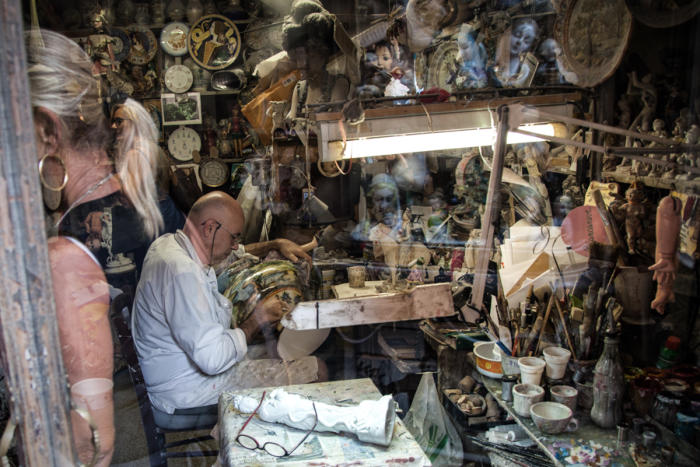
Passers-by are reflected in the window of the workshop, where proprietor Federico Squatriti (age 54) restores a vase.
The shop was originally opened by his grandmother, his father and his uncle in 1953.
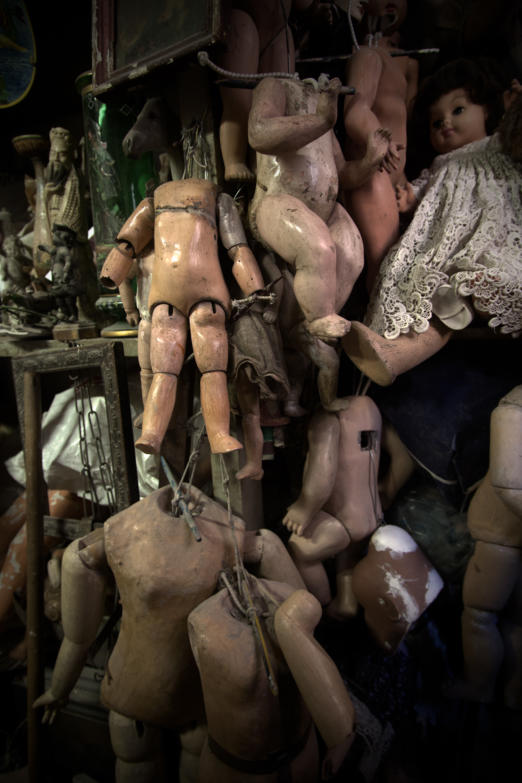
The bodies of broken antique dolls wait to be repaired or used for spare parts in the
workshop
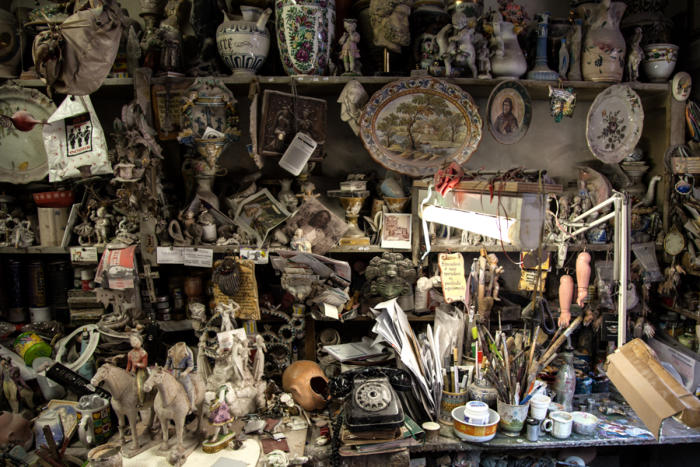
Broken antiques, porcelain, doll parts, paintbrushes and more crowd overflowing shelves at Restauri Artistici Squatriti.
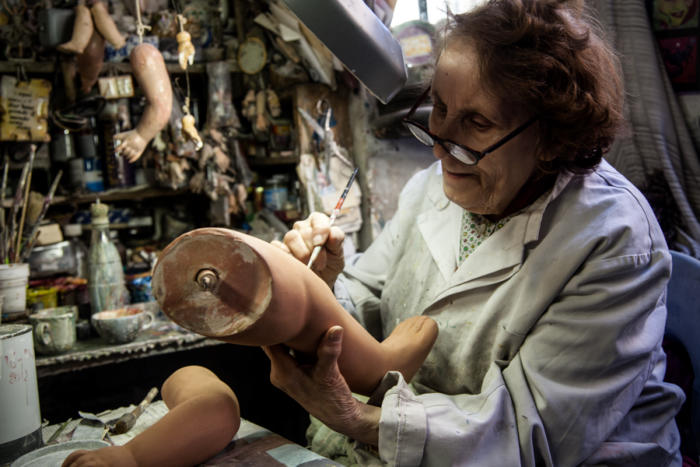
Federico Squatriti's 84-year-old mother, Gelsomina Squatriti, works on the leg of an antique porcelain doll.
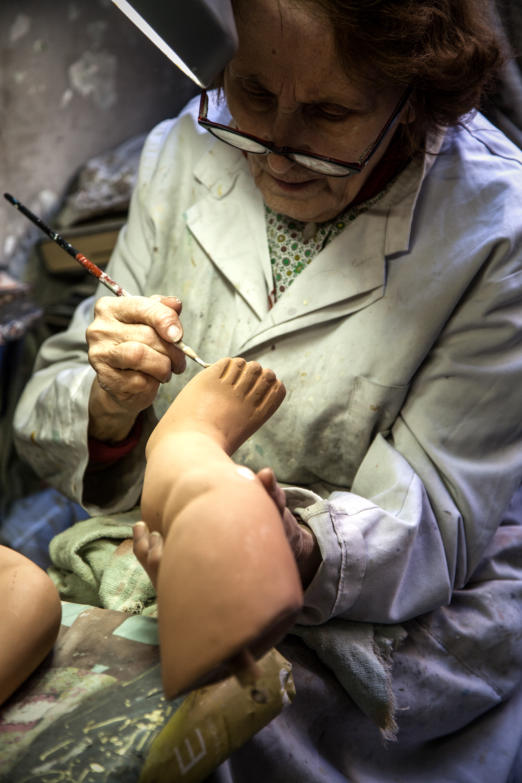
Federico Squatriti's 84-year-old mother, Gelsomina Squatriti, works on the leg of an
antique porcelain doll.
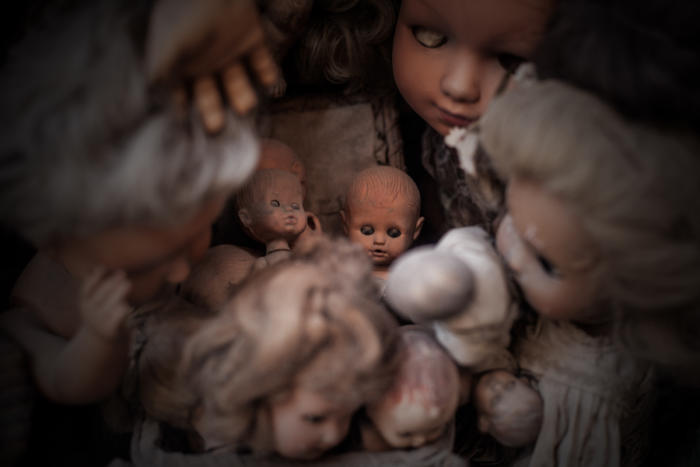
Broken and abandoned toys at Rome's "Hospital of the Dolls".
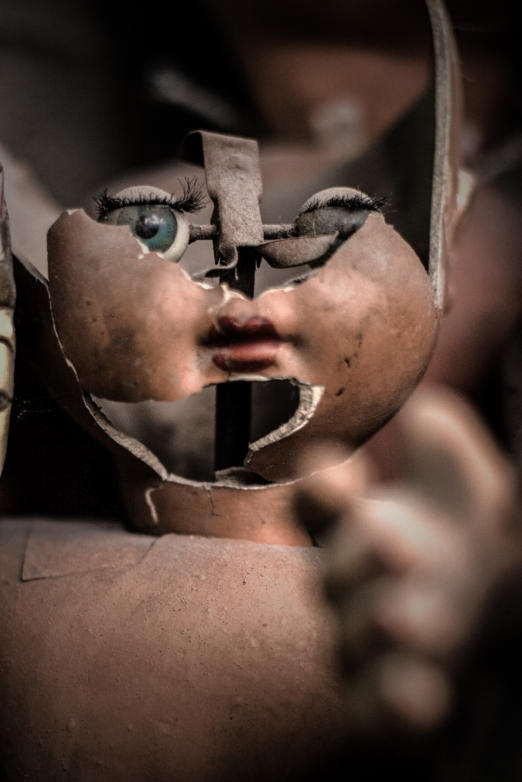
A badly damaged antique doll, likely to be used for spare parts.
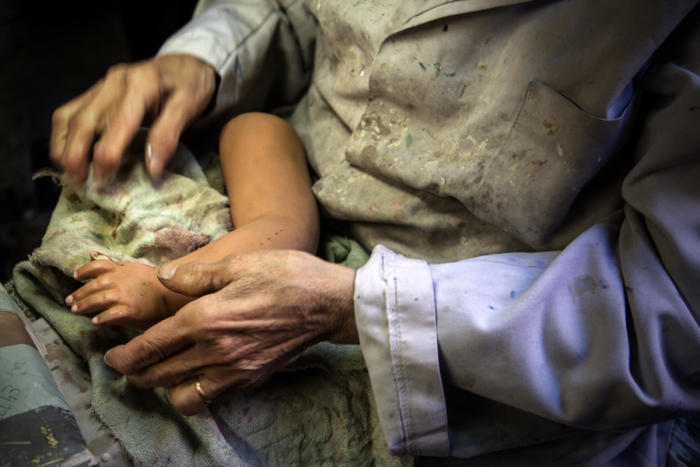
Gelsomina Squatriti carefully restores the arms of an antique doll.
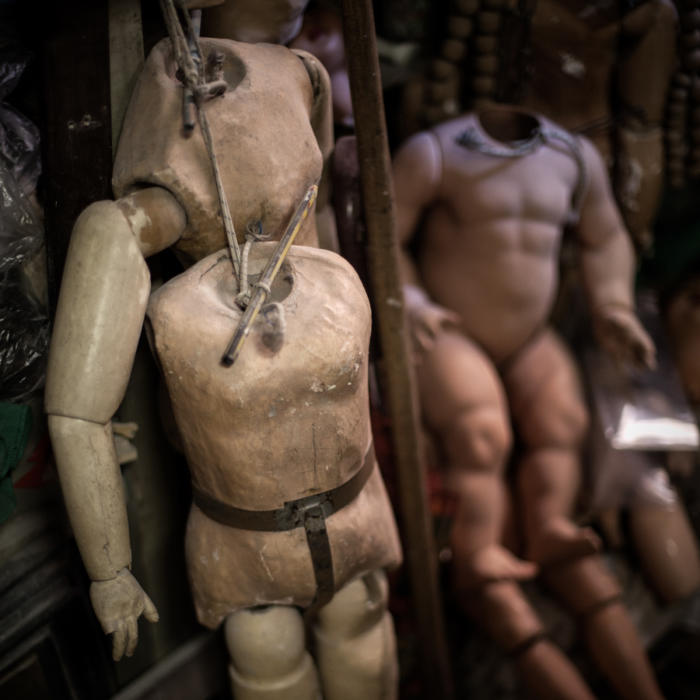
The bodies of broken antique dolls hang from workshop walls.
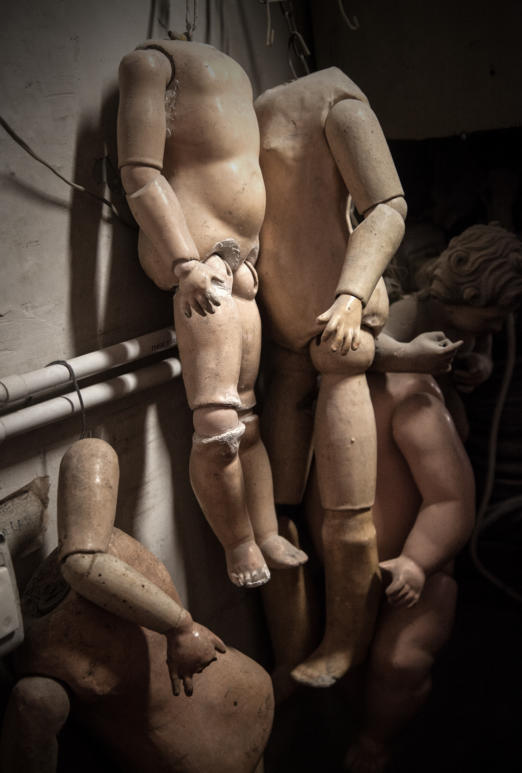
The bodies of broken antique dolls hang from workshop walls.
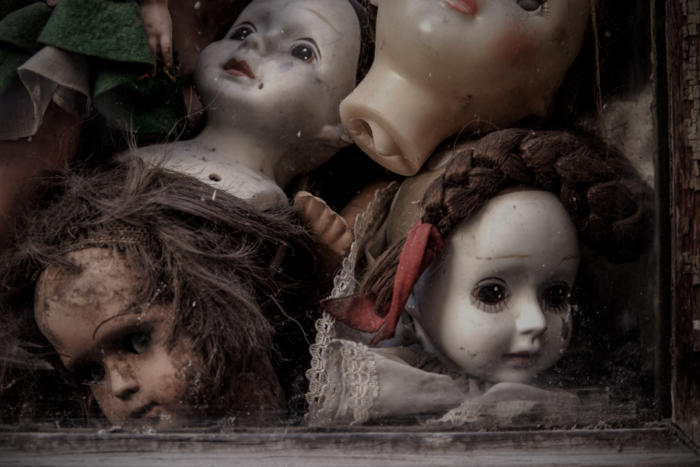
Abandoned dolls appear to gaze longingly from the window of Rome's "Hospital of the Dolls".
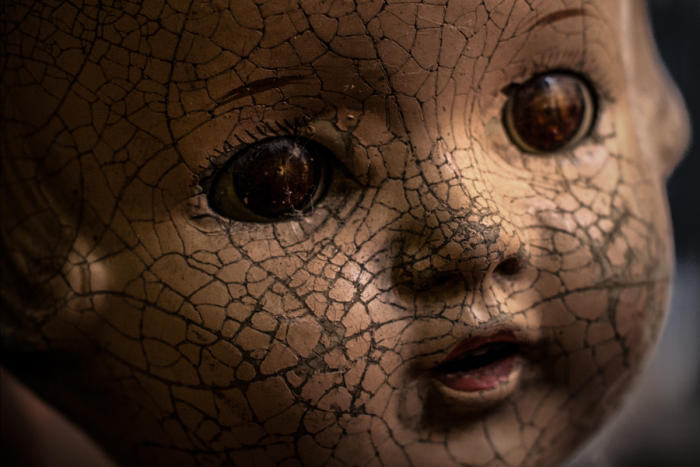
The aged and cracked head of an antique doll, which waits to be restored.

Struggling with rising costs in the 21st century, Federico Squatriti prefers to work longer hours than increase prices. “It’s
something you do for your customers, not just for money,” he says. “It’s satisfying for me, at the end of the day, to say to
myself, ‘I’ve worked for 11 hours, the result came out beautifully, and I managed to do it for a reasonable price.’ The
people are happy and I am happy. It’s all beautiful!”











